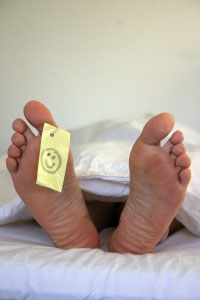 The foot is the terminal section of our limb which bears the entire weight of the body. It is responsible for all our locomotive actions. Owing to its position, this section of the body is constantly in touch with mud and dirt. It is also one of the most neglected parts of our body. But, specialists who deal with different conditions and ailments of the feet can reveal the general health condition of an individual by giving one glace at the feet.
The foot is the terminal section of our limb which bears the entire weight of the body. It is responsible for all our locomotive actions. Owing to its position, this section of the body is constantly in touch with mud and dirt. It is also one of the most neglected parts of our body. But, specialists who deal with different conditions and ailments of the feet can reveal the general health condition of an individual by giving one glace at the feet.
What Your Feet Say About Health
- The feet has 25 percent of the body’s bone structures, 33 joints, 100 tendons and countless number of nerves which are connected to the distinct organs like the spine and the brain of the central nervous system.
- Ignored problems of the feet can cause unexpected health crises increasing the risk of developing a range of interconnected ailments.
- For instance, a sore in the feet or a fracture can keep a person restricted to bed for a considerable amount of time. This can lead to a rapid increase in the weight gain of the body.
- Such an undesirable change in the body lead to consequences like shift in the body weight balance, rise in the body weight by accumulation of fat and infections.
- The Spoonlike shape of the toenail beds indicates deficiency of iron in the blood. Internal bleeding or menstrual period can start this state technically known as anemia.
- Shortness of breath, headache, fatigue are some of the common signs of this condition.
- No presence of any hair on the feet indicate poor circulation of blood to the region of the heart.
- Thickening of the pathways of the heart causes reduced supply of oxygen rich blood to the remote corners of the body as a part of its priority measure.
- Any such subtle observation should be immediately conveyed to the family physician who can prescribe certain diagnostic tests to properly assess the present condition of the heart and would suggest appropriate measures on time.
- Frequent cramping of the feet indicates lack of calcium, potassium and magnesium in the food.
- A sore that does not heal is a major indicate of high glucose level in the blood or the state of diabetes.
- The experience of cold feet especially in women above the age of 40 indicates malfunctioning of the thyroid gland as far as its function of regulation of the body temperature is concerned.
- Thich, yellow colored and ugly looking toenail indicates the presence of an infection, especially in people suffering from diabetes, rheumatoid arthritis and heart ailments.
- A red hot swollen toe joint might suggest the development of gout, particularly in individuals above the age of 65 years.
- Sore toe joints are the common symptoms of the degenerative autoimmune ailment rheumatoid arthritis.
- Deep or shallow holes in the nails are clear indicators of psoriasis arthritis, which is a skin disease. These people also have dry, swollen and red-colored knuckles.
- The damage of a nerve or muscle in the region makes it difficult for a person to lift the feet upward from the heel.
- Dry and flaky skin of the foot indicate the condition known as athlete’s foot which further extends to the soles.
- People below the age of 25 years or above 40 years can develop a condition in the winter called the Raynaud’s attack. Here the blood in the vessels of the foot overreacts for unknown reasons and cause tricolor like patterns on the skin.
- Inability to walk properly can indicate undiagnosed stress fracture especially in women above the age of 55 years.
- Clubbing of the tip of the toes indicates the presence or early development of ailments like pulmonary fibrosis, lung cancer, heart disease and certain gastrointestinal diseases like Crohn’s disease.
